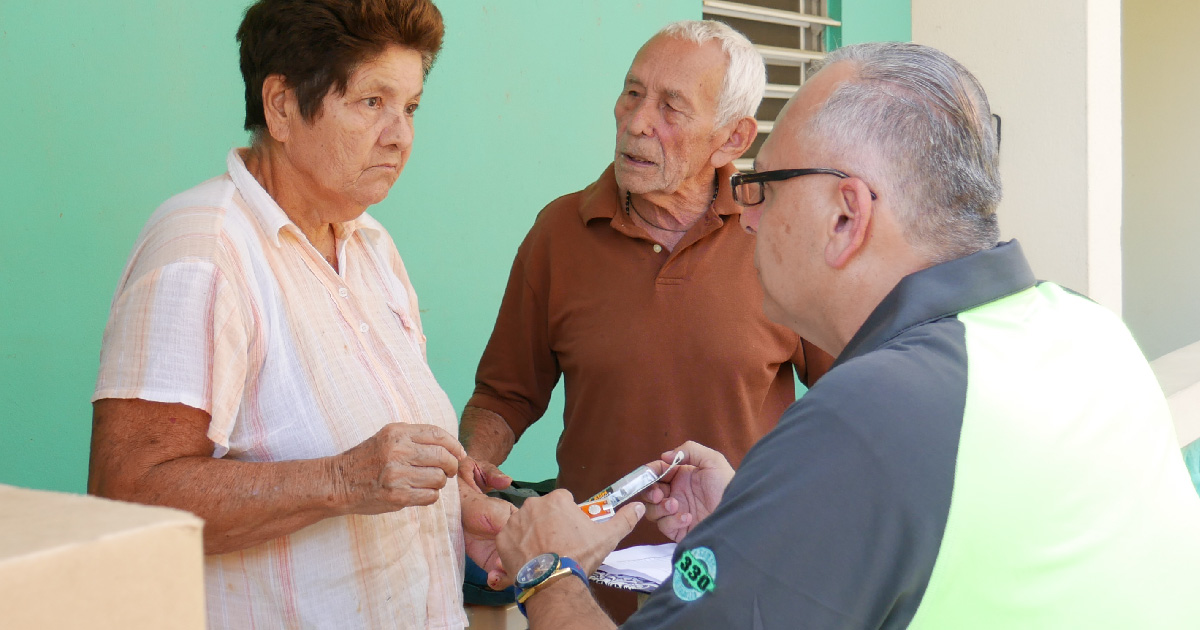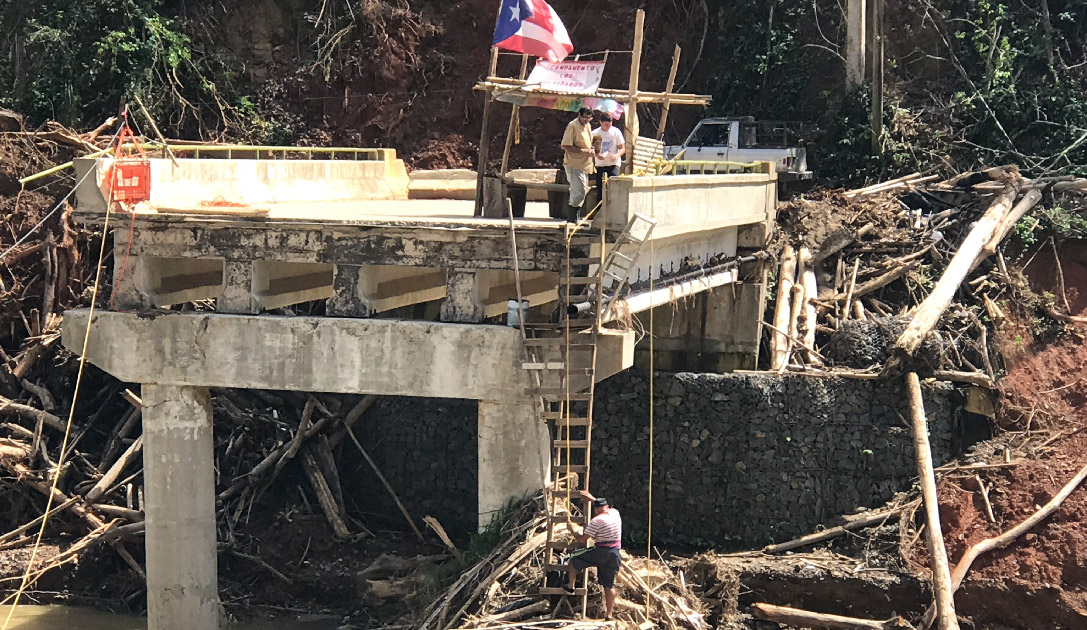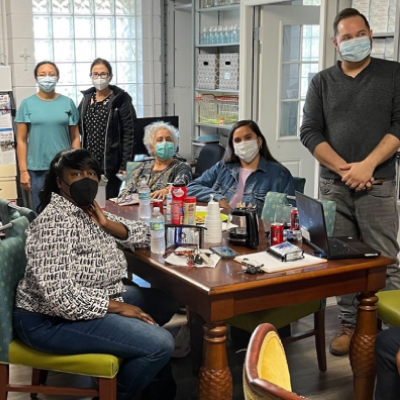- Who We Are
- Clinician Employment
- Publications
- Witness to Witness (W2W)
- El Premio Kugel & Zuroweste a la Justicia en la Salud
- Your Voice Matters: Photovoice Project
From Streamline: How Three Communities in Puerto Rico Mobilized to Prepare for the Next Big Disaster
Thu, 11/21/2019 | by Claire Hutkins Seda


CSM went door-to-door checking on their patients after Hurricane Maria.
[Editor’s Note: Did your issue of Streamline arrive in your mailbox recently? If you aren’t a subscriber, you can get the quarterly in-print journal free of charge by emailing your snail-mail address to contentedu@migrantclinician.org. You can also read our back issues on our Streamline webpage. To celebrate the release of the Autumn 2019 issue, we present one of the feature articles from the issue.]
Two years ago, Hurricane Maria slammed into Puerto Rico, dismantling basic infrastructure. Most of the island was left without water, food, power, transportation, or communication for weeks, and in many cases, months. Almost 3,000 people died.[1][2] Fused into the mourning is the stark reality that another storm of such magnitude and destruction can happen again. In the aftermath of the hurricane and to encourage public preparedness for future hurricanes, the Puerto Rican government launched a campaign that runs on television, radio, and social media, recommending that residents have ten days’ worth of food and water on hand. Marysel Pagán Santana, MS, DrPH, Program Manager for Migrant Clinicians Network based in San Juan, recognizes that such a store of food and water is unattainable and not sustainable for many Puerto Ricans.
“For many people, their first need is to eat,” and, with limited income, they may be unable to stock up on water for the future when they need their money to pay for basics now, she said. Additionally, some Puerto Ricans with chronic diseases may struggle to find shelf-stable foods that will meet their dietary needs. “If you have chronic kidney disease or diabetes, it’s not as easy as ‘buy food and put it on the shelf,’” Dr. Pagán Santana said. A recognition of the complexities of emergency preparedness, and a community-built and -informed plan to address them, are at the center of MCN’s “Mobilizing Communities in Puerto Rico to Meet the Needs of Vulnerable Populations Before, During, and After a Natural Disaster,” which launched projects in three Puerto Rican rural communities one year ago under a two-year grant from the Bristol-Myers Squibb Foundation. Each community has since risen to the challenge, and the initial results of their projects were presented during a plenary session at the East Coast Stream Forum in October in San Juan. The results, says Dr. Pagán Santana, are specific to and tailored for the community, but include applicable lessons in community mobilization.
“The three projects are being molded by both what the community needs and what the community can make work, because each community works differently,” Dr. Pagán Santana said. Each community drafted plans and maps to respond to identified community vulnerabilities, and include the participation of various actors in the community and the local community health center. For this project, MCN identified three communities within the service areas of community health centers and longtime MCN partners Corporación de Servicios Médicos (CSM) and Hospital General Castañer. Corporación de Servicios Médicos, a large community health center serving several rural communities, was the health center partner for Parcelas Ángel Vélez and Comunidad Manuel Candelaria, two small communities within the town of Bayoan in the Hatillo municipality. The third community, Castañer, partnered with their health center, Hospital General Castañer.
Parcelas Ángel Vélez
The residents of Parcelas Ángel Vélez, a northern coastal village, already had developed a community program around security, one that involved a cross-section of community leaders including local police. Consequently, when leaders came together to envision how to begin their community mobilization plan, the security council was designated to be the driver of the new project. The council, which already had office facilities and buy-in from the community, could pivot their attention toward training their team on emergency preparedness and activate pre-existing partnerships, like with local government leaders, on issues around disasters. This already-established community infrastructure gave Parcelas Ángel Vélez a head start, says Dr. Pagán Santana. “They worked fast on mapping where the flooding streets would be, who lives there, and how they’re going to address the floods,” Dr. Pagán Santana said. They partnered with CSM to determine where their most vulnerable community members are in relation to the flood maps, including patients that cannot easily leave their houses and patients with chronic illnesses, to map out where resources and medical supplies needed to go.
“They were already a team, so they were used to meeting monthly, they were already engaged, and they had already identified themselves as leaders in the community, so they were willing to take on the responsibility of sustaining the plan,” Dr. Pagán Santana reflected. “They know it’s a long-term project.”
For each of the health centers, MCN provided training and technical assistance. As they engaged in the community, MCN extended to the health centers targeted technical assistance based on project activities. When the team in Parcelas Ángel Vélez determined part of their emergency plan would include a warehouse to accept supplies, for example, MCN stepped up to provide a training on supplies management, a skill with which none on the team had previous experience. “When you’re in charge of supplies and dispatching them, you need to be careful how you organize it. You don’t want to provide the wrong medicine or spoiled food,” Dr. Pagán Santana noted. The final results include an extensive community mobilization plan, community vulnerability maps, strengthened partnerships with the health center, and a dedicated team of community members to review the plan on an annual basis.
Comunidad Manuel Candelaria
In neighboring Comunidad Manuel Candelaria, also served by CSM, community leaders were less organized, and also less inclined to identify as leaders, which led to early organizational hiccups. “The community leaders do activities for the community like a Christmas tree lighting, but they’re not incorporated, and they don’t identify as a team,” said Dr. Pagán Santana. “When Maria happened, people were reaching out to them,” reflecting the community’s recognition of their status as leaders, but the leaders were reticent to define themselves as such. Part of the process was to help those leaders accept their leadership and the responsibilities that come with it, or abnegate it and allow someone else to step up. “Many of them were willing to serve. But there was resistance to being appointed to have the responsibility to carry out [an emergency] plan,” Dr. Pagán Santana found. As a result, the health center stepped up to provide the long-term structure, where community leaders can fill in, rather than asking the community leaders to be the head of the plan, with the health center as a support. Under the plans, CSM will restructure one of its health fairs each year to focus on emergency preparedness, including door-to-door visits to update maps on patients who may be more vulnerable after a hurricane. With CSM fully on board, and a structure in place, community leaders were willing to step up and lend their part as organizers and point-people in the community. “There was more willingness to commit when the community health center was backing it,” Dr. Pagán Santana concluded, and the team was able to move forward with developing the nuts and bolts of the plan. “The community health center will help sustain the plan, even though they’re not running it.”

Hurricane Maria wiped away this bridge, completely cutting off a small community nestled in the mountains of Puerto Rico.
Castañer
Each community ran into different barriers. In Castañer, the barriers were significant. At the onset of the project, outreach workers from Hospital General Castañer began knocking door-to-door to determine the level of preparedness that residents already had, to begin developing maps of patients who would need help immediately after an emergency. Instead, they found patients needing immediate help now. They met elderly residents living in homes with damaged roofs, patched with blue tarps, and unable to get government assistance. Numerous households had family members struggling with mental and chronic illnesses that had gone unaddressed or undiagnosed. Some families didn’t have sufficient access to food.
“This community had more difficulty because it presented barriers unrelated to team organization: emergency response and services hadn't reached the community” before, during, and after Hurricane Maria, Dr. Pagán Santana said. As a result, many community members face tremendous overlapping health concerns that have been unaddressed. Additionally, community members are “used to not expecting anything,” Dr. Pagán Santana found, and frequently don’t have access to services that they pay for like running water, power, or even an ambulance when needed.
“How can you get prepared for an emergency, if you [currently] don’t have enough food in your house to eat? If your school is closed, and you have to travel two hours from your home to get to a school -- how do you prepare?” Dr. Pagán Santana questioned. The health center team felt overwhelmed and frustrated, so the team regrouped to determine the best next steps for the community.
“We decided to work on getting resources,” Dr. Pagán Santana said. MCN provided a training on community mobilization for advocacy, which case workers could use to encourage community members to advocate by identifying the community’s needs and talking with local legislators. They also began resource-mapping government and private resources available to the community, for basic services beyond emergency assistance.
Finally, they mobilized the hospital’s case workers and social workers to prepare for an influx of new cases. Now, when the health team goes into the community, they are armed with resources and next-steps for people who exhibit concerns outside of emergency preparedness which may be more urgent, allowing an avenue to address current needs while anticipating and documenting future post-disaster needs.
“It’s not just about the plan; it’s about how you build around it to make it sustainable, and what else you can address that may have an impact in disaster preparedness,” noted Dr. Pagán Santana. “You think it’s all about making a plan or buying supplies -- but not everyone can prepare in the same way.” For Castañer, the health team needed to step back before they could move forward.
Stream Forum Plenary and Next Steps
With the three community’s plans completed and presented to the communities, the next step is to implement them. Dr. Pagán Santana will facilitate meetings with community health center staff and managers to finalize implementation into workflows to sustain the project into the future.
In October, Dr. Pagán Santana and MCN’s partner health centers presented their initial findings, outlined the process they went through, and indicated ways to use this community mobilization framework for other concerns beyond emergency preparedness at the plenary session at the East Coast Migrant Stream Forum in San Juan.
For the project’s second year, four more communities will develop plans and maps. CSM plans to complete the process a third time, with a different community in its service area. MCN hopes to extend the project to more communities in Puerto Rico and beyond.
Contact Marysel Pagán Santana, MS, DrPh, for more on this project: mpagan@migrantclinician.org.
References
[1] Milken Institute School of Public Health, George Washington University. Project Report: Ascertainment of the Estimated Excess Mortality From Hurricane Maria in Puerto Rico. 2018. Available at: https://prstudy.publichealth.gwu.edu/.
[2] Santos-Burgoa C, Sandberg J, Suárez E, et al. Differential and persistent risk of excess mortality from Hurricane Maria in Puerto Rico: a time-series analysis. Lancet Planetary Health. 2018;2(11). doi:10.1016/s2542-5196(18)30209-2.
[1] Milken Institute School of Public Health, George Washington University. Project Report: Ascertainment of the Estimated Excess Mortality From Hurricane Maria in Puerto Rico. 2018. Available at: https://prstudy.publichealth.gwu.edu/.
[2] Santos-Burgoa C, Sandberg J, Suárez E, et al. Differential and persistent risk of excess mortality from Hurricane Maria in Puerto Rico: a time-series analysis. Lancet Planetary Health. 2018;2(11). doi:10.1016/s2542-5196(18)30209-2.
Like what you see? Amplify our collective voice with a contribution.
Got some good news to share? Contact us on our social media pages above.
Return to the main blog page or sign up for blog updates here.







